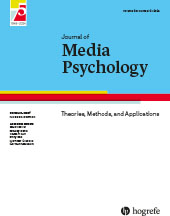Abstract
Abstract. TV news are essentially cultural phenomena. Previous research suggests that the often-overlooked formal and implicit characteristics of newscasts may be systematically related to culture-specific characteristics. Investigating these characteristics by means of a frame-by-frame content analysis is identified as a particularly promising methodological approach. To examine the relationship between culture and selected formal characteristics of newscasts, we present an explorative study that compares material from the USA, the Arab world, and Germany. Results indicate that there are many significant differences, some of which are in line with expectations derived from cultural specifics. Specifically, we argue that the number of persons presented as well as the context in which they are presented can be interpreted as indicators of Individualism/Collectivism. The conclusions underline the validity of the chosen methodological approach, but also demonstrate the need for more comprehensive and theory-driven category schemes.
Zusammenfassung. Fernsehnachrichten sind kulturell bedingte Phänomene. Bisherige Forschungsergebnisse sprechen zusätzlich für einen systematischen Zusammenhang zwischen den - häufig übersehenen - formalen und impliziten Charakteristika von Nachrichtensendungen und kulturspezifischen Dimensionen. Eine auf Einzelbildern basierende Inhaltsanalyse wird in dieser Hinsicht als besonders viel versprechender Untersuchungsansatz identifiziert. In einer explorativen Studie werden mögliche Zusammenhänge zwischen Kultur und ausgewählten formalen Merkmalen von Fernsehnachrichten dreier Kulturen (USA, arabische Länder, Deutschland) geprüft. Die Ergebnisse weisen auf eine Vielzahl von Unterschieden hin, von denen einige mit Erwartungen übereinstimmen, die sich aus grundlegenden Kulturunterschieden ableiten lassen. Wir argumentieren, dass insbesondere die Anzahl der im Bild gezeigten Personen und der jeweils dargestellte Handlungskontext als Indikatoren von Individualismus/Kollektivismus interpretiert werden können. Die diskutierten Schlussfolgerungen unterstreichen grundsätzlich die Validität des gewählten methodischen Ansatzes, zeigen aber gleichzeitig auch die Notwendigkeit einer weiteren Differenzierung und stärkeren theoretischen Verankerung des Kategoriensystems.
References
(1997). Formale Angebotsweisen und interpersonelle Kommunikationsmuster im Affekt-Talk [Media formats and interpersonal communication patterns within affect-talk]. In G. Bente & B. Fromm (Hrsg.), Affektfernsehen. Motive, Angebotsweisen und Wirkungen [Affect television. Motives, media formats and effects] (S. 186-242). Opladen: Leske und Budrich
(1992). Visuelle Zitate als Mittel der Fernsehberichterstattung in Deutschland, Frankreich und den USA [Visual quotations as a method of media coverage in Germany, France, and the U.S.] (Forschungsbericht/research report). Weinheim: DFG
(2004). Inhaltsanalyse medialer Angebote [Content analysis of media products]. In R. Mangold, P. Vorderer & G. Bente (Hrsg.), Lehrbuch der Medienpsychologie [Textbook of Media Psychology] (S. 201-227). Göttingen: Hogrefe
(1992). When fiction and news cross over the border: Notes on differential readings and effects. In F. Korzenny, S. Ting-Toomey & E. Schiff (Eds.), Mass Media Effects Across Cultures (pp. 23-34). Londres: Sage
(1981). Schemata for understanding television. In H. Kelly & H. Gardner (Eds.), Viewing children through television (pp. 31-46). San Fransisco: Jossey Bass
(1992). Mass media and society . London: Edward Arnold
(1980). Culture’s Consequences: International differences in work-related values . Newbury Park, CA: Sage
(2003). Culture’s Consequences (2 ed.). Sage Publications Inc (USA) - Corwin Press
(1998). Fernsehnachrichten, Strukturen, Prozesse, Funktionen [Television news, structures, processes, functions]. Opladen: Westdeutscher Verlag
(2001). Film, Form, and Culture (2ed.). New York: Mcgraw-Hill
(1992). Mass media effects across cultures . Thousand Oaks: Sage Publications, Inc.
(1991). Dominance and Attention - Images of Leaders in German, French, and American Tv-News. Polity, 23(3), 373– 394
(2002). McLuhan Unbound . Corte Madera, CA: Gingko Press
(1994). Visual ‘Literacy’: Image, Mind and Reality . Boulder, CO: Westview Press
(1986). No sense of place: The impact of electronic media on social behavior . Oxford: Oxford University Press
(1989). Politik im Fernsehen: Zur Personalisierung in den Fernsehnachrichten der USA, Frankreichs und der Bundesrepublik Deutschland [Politics on TV: About the personalization in television news in the U.S., France and Germany]. Düsseldorf
(1985). Amusing ourselves to death . New York: Viking
(2004). Political communication messages. Pictures of our world on Television news. In F. Esser & B. Pfetsch (Eds.), Comparing political communication. Theories, cases and challenges (pp. 271-292). Cambridge: Cambridge University Press
(1979). The interaction of media, cognition and learning . San Fransisco: Jossey-Bass
(1998). Investigating the determinants of international news flow: A meta-analysis. The International Journal for Communication Studies, 60(6), 493– 512
(2000). Systemic determinants of international news coverage: A comparison of 38 countries. Journal of Communication, 50(2), 110– 130



